Key Points
- The ecosystem and geography of South America make it a biodiversity hotspot.
- Around 800 snake species inhabit South America, but only about 120 are venomous.
- The heaviest snake in the world lives here, reaching lengths of about 20 feet and up to 550 pounds.
South America is home to the Amazon River, the Andes Mountains, and the Atacama Desert. But, this incredible continent is famous for even more than its geographic features. It is also home to some of the world’s most fascinating creatures, including mammals, birds, insects, and especially reptiles.
Approximately 800 species of snake call South America their home. Out of these species, 120 are venomous. Hiding, maybe not-so-inconspicuously, in the northern regions of the country is the largest snake in the world. Here, we’ll learn about the 10 largest snakes in South America. Number one on our list is big enough to eat a full-grown deer!
Read on to learn more about the ten largest snakes in South America.
10. Emerald Tree Boa
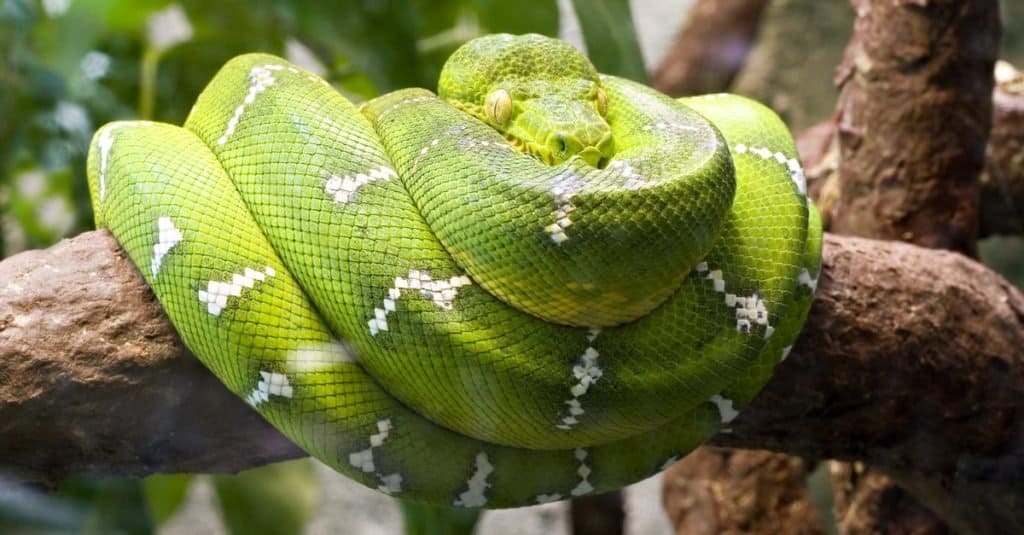
Unlike venomous species, like king cobras and
black mambas
, emerald tree boas lack venom, relying instead on constriction.
©Hannamariah/Shutterstock.com
True to its name, the emerald tree boa is bright green, with delicate white markings. Emerald tree boas grow up to six feet long. As juveniles, their coloring ranges from bright red to orange, turning green as they age. These boas live in Brazil, Peru, Venezuela, Colombia, Guiana, and Suriname. They spend nearly their entire lives in the trees, feeding on birds, reptiles, amphibians, and small mammals.
9. Rainbow Boa
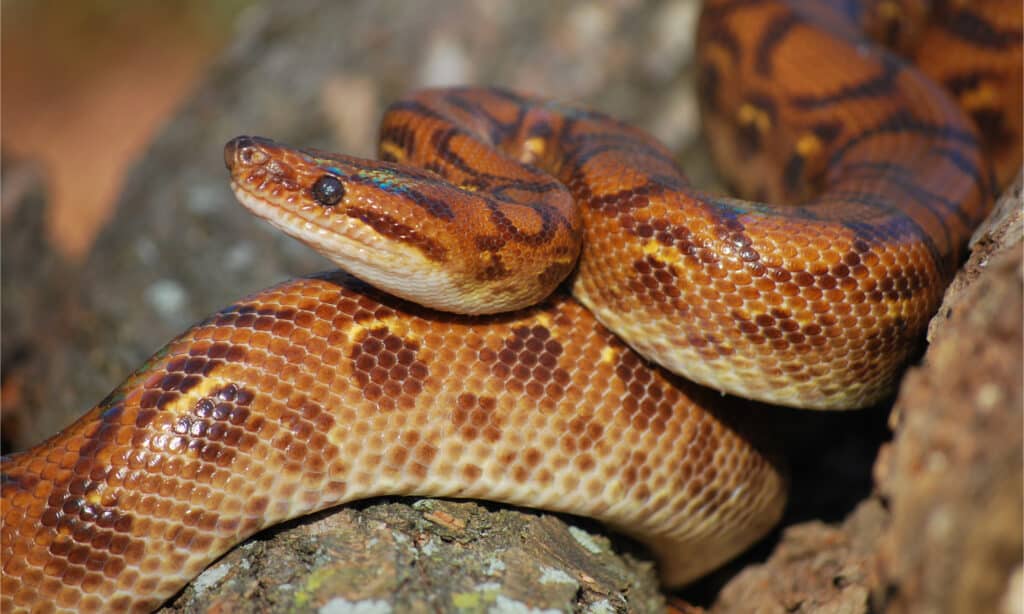
As their name suggests, the
rainbow boa
has iridescent scales that reflect the colors of the rainbow.
©Kassia Marie Ott/Shutterstock.com
One of the largest snakes in South America is the rainbow boa. They grow up to six feet long and have heavy bodies designed for life on the ground. Rainbow boas live mostly in hot, humid forests, though they’re sometimes found in open lands. Their native habitat ranges from Venezuela to the Amazon River basin. Like other constrictors, they kill their prey by squeezing it to death, before swallowing it whole. Typical prey items include birds, rodents, amphibians, and reptiles.
8. Fer-de-lance

Also known as the Terciopelo, the Fer-de-lance has deadly venom and large fangs.
©David Havel/Shutterstock.com
Fer-de-lance snakes grow up to seven feet long. They’re pit vipers, which means they have heat-sensing abilities and are closely related to rattlesnakes and cottonmouths. Fer-de-lances live in northern South America, Colombia, Venezuela, Guyana, and Ecuador. When threatened, fer-de-lances famously stand their ground, and may even bite in self-defense. Their base color is light brown, with darker and lighter brown scales interspersed to create a camouflage pattern.
7. Dark Spotted Anaconda
Dark Spotted anacondas may not be the biggest anaconda out there, but they’re still one of the largest snakes in South America. These little-known snakes grow up to eight feet long, with females growing larger than males. They get their name from the dark blotches that cover most of their body, which has a base color of olive green to yellow-brown. Dark spotted anacondas frequent waterways and semi-aquatic environments.
6. Brazilian Smooth Snake
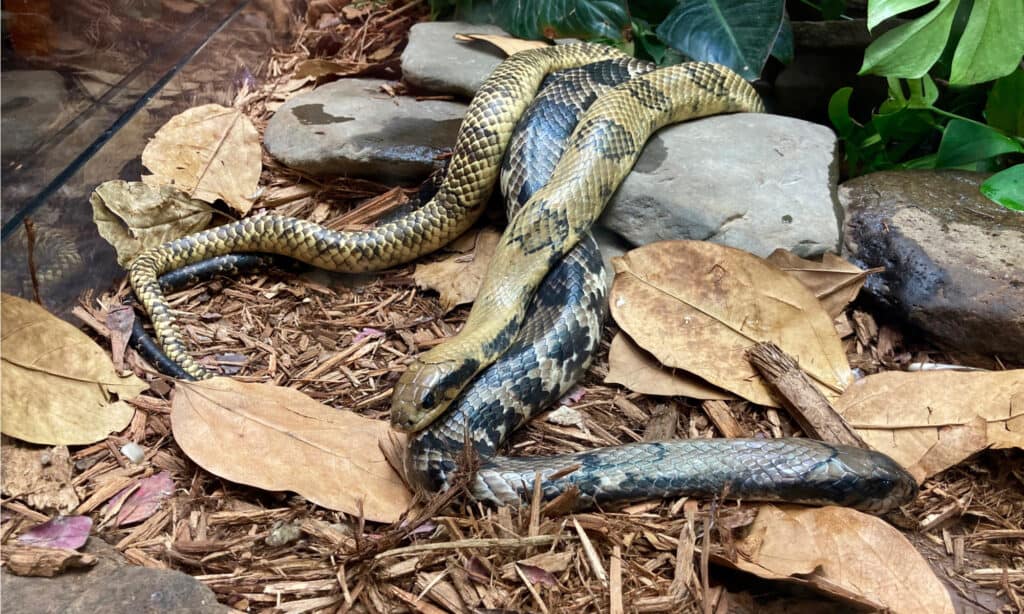
Also known as the false water cobra, these snakes have flattened hoods like true cobras.
©Juli V/Shutterstock.com
The Brazilian smooth snake is one of the largest snakes in South America, though it’s still dwarfed by number one on our list. These snakes grow up to nine feet long and are one of the longest venomous snakes in South America. They have light tan bodies with chevron patterned dark brown to black stripes. Brazilian smooth snakes live throughout many parts of central South America and prefer humid rainforests and wetlands. Fish and frogs make up most of their diet.
5. Tiger Rat Snake
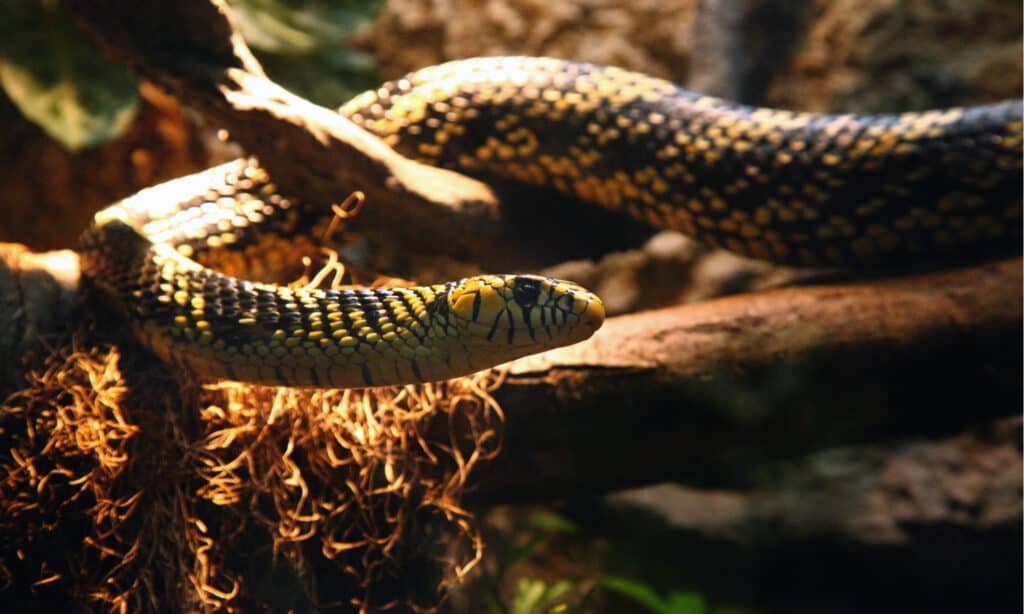
Endemic to both Central and South America, the tiger
rat snake
is commonly known as the chicken snake.
©Ixepop/Shutterstock.com
Tiger rat snakes live throughout central and northern South America. They grow up to 10 feet long and lack venom. Their coloring ranges from bright yellow to dull tan with black stripes. Tiger rat snakes spend most of their lives in the trees but occasionally come to the ground to hunt. They’re opportunistic hunters and will feed on everything from small mammals to birds.
4. Boa Constrictor
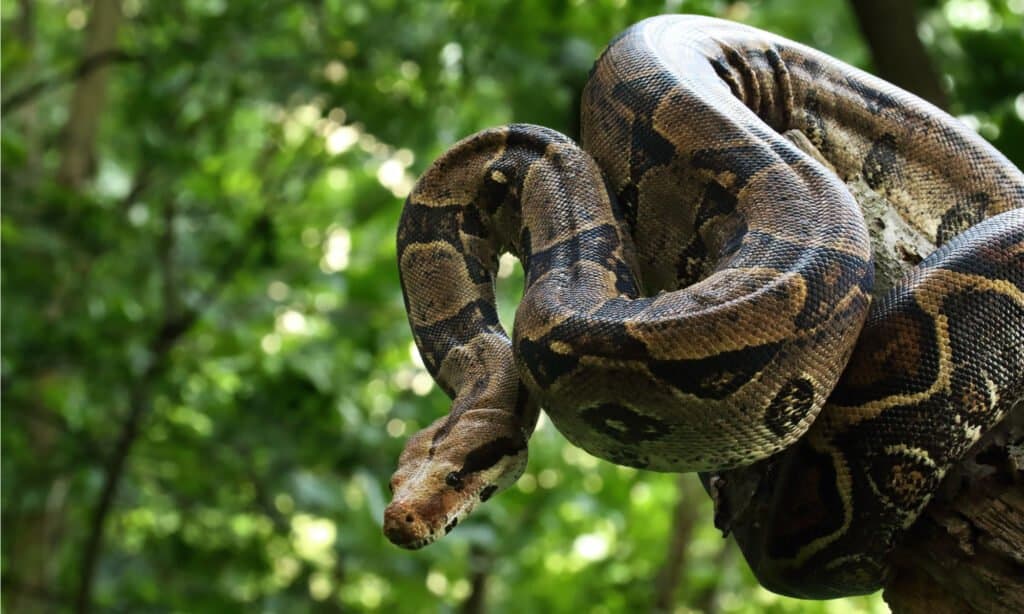
A popular reptile for zoos and snake enthusiasts, the
boa constrictor
comes in many different colors.
©Jan Hejda/Shutterstock.com
Boa constrictors are heavy-bodied snakes, the largest can weigh more than 100 pounds. They’ve got the length to match that girth too, with the largest boa constrictors reaching up to 13 feet long. Some grow even bigger; there are reports of boa constrictors in captivity growing up to 18 feet long. These snakes live throughout much of South America, where they spend most of their time in or around rivers or lakes. Because of their size, boa constrictors can hunt medium-sized prey, like wild pigs and deer.
3. Bushmaster
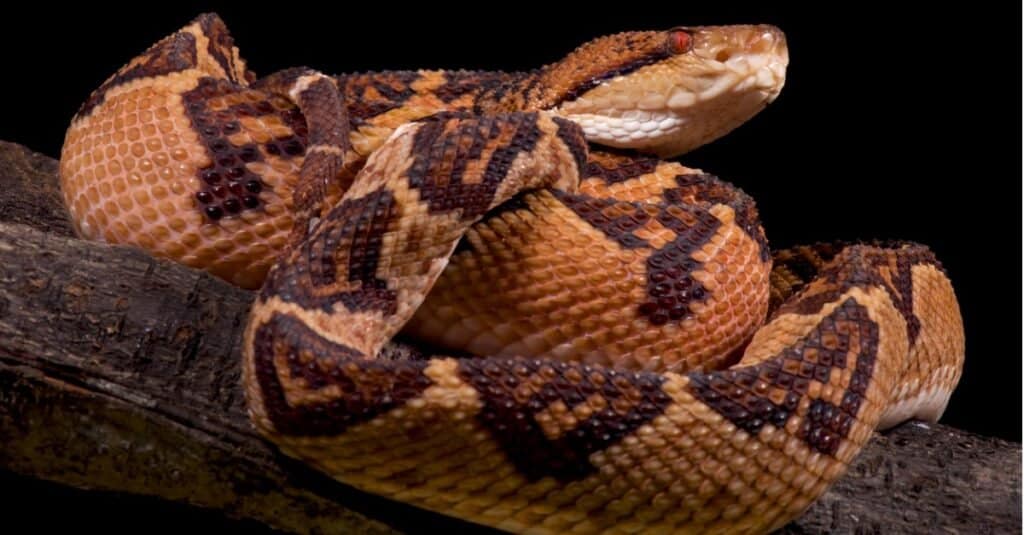
The bushmaster is one of the heaviest vipers in the world, coming in just behind the Gaboon viper and
Eastern diamondback rattlesnake
.
©iStock.com/reptiles4all
Bushmasters are one of the largest snakes in South America; they can grow up to 13 feet long. They’re the longest venomous snake in the western hemisphere. As pit vipers, their mouths contain impressive, venom-delivering fangs and heat-sensing pits. Most of their bodies are copper-colored, with pale undersides and black markings. When threatened, they coil up and rattle their rattle-less tails in a warning.
2. Yellow Anaconda
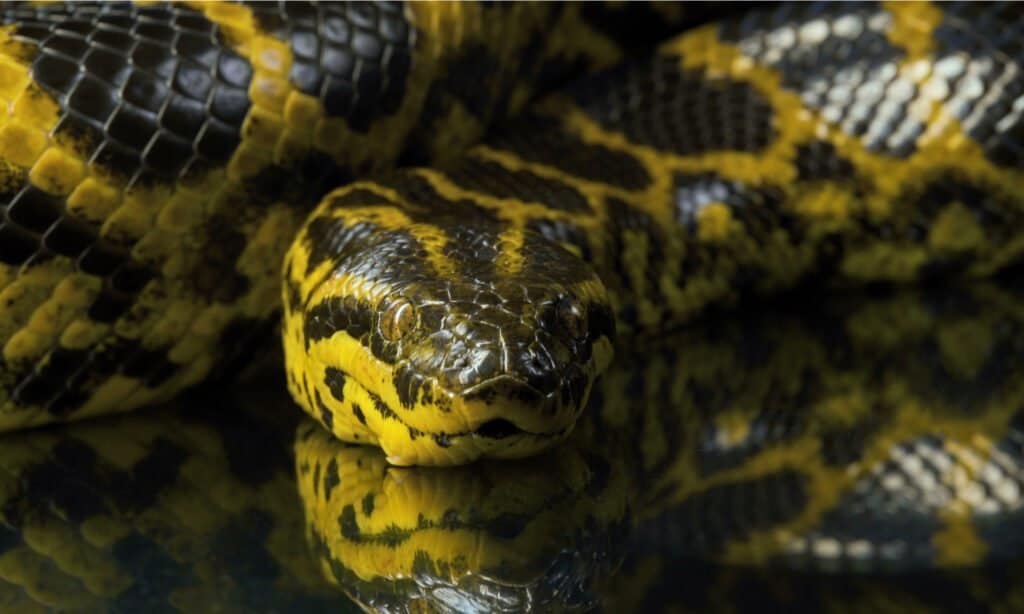
Like all anacondas, the yellow anaconda has distinct coloring and markings. Their bodies are yellow to light brown, with dark brown circular and ovoid splotches along the back and sides.
©Chris Tefme/Shutterstock.com
The yellow anaconda is one of the largest snakes in South America. Females grow bigger than males, reaching up to 15 feet long. The largest yellow anacondas weigh over 100 pounds. These snakes spend most of their time hunting in wetlands and shallow lakes and ponds. Like other constrictors, they use their massive bulk to overpower and suffocate prey. Yellow anacondas live in Paraguay, Uruguay, Bolivia, Brazil, and Argentina.
1. Green Anaconda

Native to most of the northern half of South America, green anacondas have long been the stuff of legend and myth.
©Vladimir Wrangel/Shutterstock.com
The green anaconda is without a doubt the largest snake in South America. At up to 20 feet long, they’re one of the longest snakes in the world. Reports of some extremely large anacondas reach as high as 33 feet, but these “monster” snakes haven’t been verified by a third-party agency.
The largest green anacondas can weigh over 150 pounds, making them the heaviest snake in the world. As their name suggests, they have a lime green color, with irregular, darker blotches.
Summary of The 10 Largest Snakes in South America
Here is a summary of the 10 largest snakes in South America and their length.
| Rank | Snake | Length |
|---|---|---|
| 1 | Green Anaconda | 20 feet |
| 2 | Yellow Anaconda | 15 feet |
| 3 | Bushmaster | 13 feet |
| 4 | Boa Constrictor | 13-18 feet |
| 5 | Tiger Rat Snake | 10 feet |
| 6 | Brazilian Smooth Snake | 9 feet |
| 7 | Dark Spotted Anaconda | 8 feet |
| 8 | Fer-de-Lance | 7 feet |
| 9 | Rainbow Boa | 6 feet |
| 10 | Emerald Tree Boa | 6 feet |
What is the Largest Snake in the World?
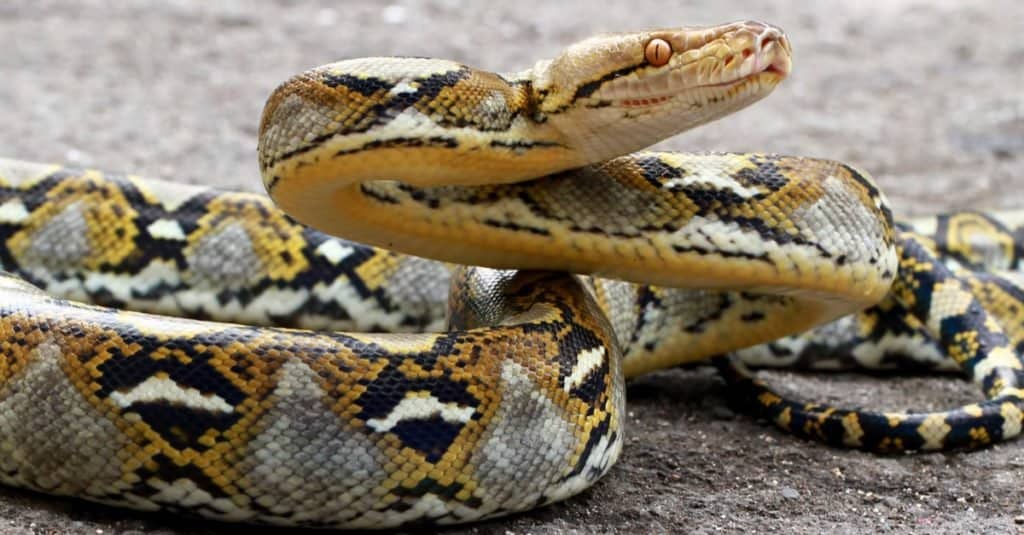
The Reticulated Python is the largest snake in the world.
©Opayaza12/Shutterstock.com
Found in the rainforests, woodlands, and grasslands of southeast Asia, reticulated pythons are the largest snakes in the world! The largest reticulated python ever recorded was discovered in 1912 and measured 32.8 feet long. The largest of these snakes held in captivity was 25 feet long and weighed around 350 pounds!
The photo featured at the top of this post is ©
Discover the "Monster" Snake 5X Bigger than an Anaconda
Every day A-Z Animals sends out some of the most incredible facts in the world from our free newsletter. Want to discover the 10 most beautiful snakes in the world, a "snake island" where you're never more than 3 feet from danger, or a "monster" snake 5X larger than an anaconda? Then sign up right now and you'll start receiving our daily newsletter absolutely free.
Thank you for reading! Have some feedback for us? Contact the AZ Animals editorial team.







